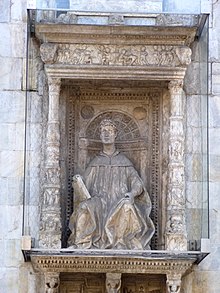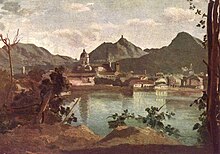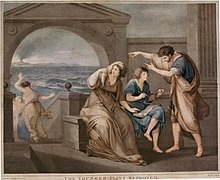Pliny the Younger
Pliny the Younger | |
|---|---|
 Statue of Pliny the Younger on the facade of Cathedral of S. Maria Maggiore in Como | |
| Born | Gaius Plinius Caecilius Secundus 61 AD Como |
| Died | c. 113 AD (aged approx. 52) Bithynia |
| Occupation | Politician, judge, author |
| Parent(s) | Lucius Caecilius Cilo and Plinia Marcella |
Gaius Plinius Caecilius Secundus, born Gaius Caecilius or Gaius Caecilius Cilo (61 – c. 113), better known as Pliny the Younger (/ˈplɪni/), was a lawyer, author, and magistrate of Ancient Rome. Pliny's uncle, Pliny the Elder, helped raise and educate him.
Pliny the Younger wrote hundreds of letters, of which 247 survive and are of great historical value. Some are addressed to reigning emperors or to notables such as the historian Tacitus. Pliny served as an imperial magistrate under Trajan (reigned 98–117),[1] and his letters to Trajan provide one of the few surviving records of the relationship between the imperial office and provincial governors.[2]
Pliny rose through a series of civil and military offices, the cursus honorum. He was a friend of the historian Tacitus and might have employed the biographer Suetonius on his staff. Pliny also came into contact with other well-known men of the period, including the philosophers Artemidorus and Euphrates the Stoic, during his time in Syria.[3]
Contents
1 Background
1.1 Childhood
1.2 Marriages
1.3 Death
2 Career
2.1 Career summary
3 Writings
3.1 Epistulae
3.1.1 Epistles concerning the eruption of Mount Vesuvius
3.1.2 Epistle concerning the Christian Religion
3.2 Manuscripts
4 Villas
5 See also
6 References
7 Further reading
8 External links
Background
Childhood

Como and Lake Como in 1834, painted by Jean-Baptiste-Camille Corot
Pliny the Younger was born in Novum Comum (Como, Northern Italy) around 61 the son of Lucius Caecilius Cilo, born there, and his wife Plinia Marcella, a sister of Pliny the Elder.[4] He was the grandson of Senator and landowner Gaius Caecilius, revered his uncle, Pliny the Elder (who at this time was extremely famous around the Roman Empire), and provided sketches of how his uncle worked on the Naturalis Historia.[5]
Cilo died at an early age, when Pliny was still young. As a result, the boy probably lived with his mother. His guardian and preceptor in charge of his education was Lucius Verginius Rufus,[citation needed] famed for quelling a revolt against Nero in 68 AD.

The Younger Pliny Reproved, colorized copperplate print by Thomas Burke (1749–1815)
After being first tutored at home, Pliny went to Rome for further education. There he was taught rhetoric by Quintilian, a great teacher and author, and Nicetes Sacerdos of Smyrna. It was at this time that Pliny became closer to his uncle Pliny the Elder. When Pliny the Younger was 17 or 18, his uncle Pliny the Elder died attempting to rescue victims of the Vesuvius eruption, and the terms of the Elder Pliny's will passed his estate to his nephew. In the same document the younger Pliny was adopted by his uncle. As a result, Pliny the Younger changed his name from Gaius Caecilius Cilo to Gaius Plinius Caecilius Secundus (his official title was Gaius Plinius Luci filius Caecilius Secundus).[6]
There is some evidence that Pliny had a sibling. A memorial erected in Como (now CIL V, 5279) repeats the terms of a will by which the aedile Lucius Caecilius Cilo, son of Lucius, established a fund, the interest of which was to buy oil (used for soap) for the baths of the people of Como. The trustees are apparently named in the inscription: "L. Caecilius Valens and P. Caecilius Secundus, sons of Lucius, and the contubernalis Lutulla." The word contubernalis describing Lutulla is the military term meaning "tent-mate", which can only mean that she was living with Lucius, not as his wife. The first man mentioned, L. Caecilius Valens, is probably the older son. Pliny the Younger confirms[7] that he was a trustee for the largess "of my ancestors". It seems unknown to Pliny the Elder, so Valens' mother was probably not his sister Plinia; perhaps Valens was Lutulla's son from an earlier relationship.[citation needed]
Marriages
Pliny the Younger married three times, firstly, when he was very young (about 18), to a stepdaughter of Veccius Proculus', who died at age 37; secondly, at an unknown date, to the daughter of Pompeia Celerina; and thirdly to Calpurnia, daughter of Calpurnius and granddaughter of Calpurnius Fabatus of Comum. Letters survive in which Pliny recorded this last marriage taking place, his attachment to Calpurnia, and his sadness when she miscarried their child.[8]
Death
Pliny is thought to have died suddenly during his convention in Bithynia-Pontus, around 113 AD, since no events referred to in his letters date later than that.[9]
Career
Pliny was by birth of equestrian rank, that is, a member of the aristocratic order of equites (knights), the lower (beneath the senatorial order) of the two Roman aristocratic orders that monopolised senior civil and military offices during the early Empire. His career began at the age of 18 and initially followed a normal equestrian route. But, unlike most equestrians, he achieved entry into the upper order by being elected Quaestor in his late twenties.[10] (See Career summary below.)
Pliny was active in the Roman legal system, especially in the sphere of the Roman centumviral court, which dealt with inheritance cases. Later, he was a well-known prosecutor and defender at the trials of a series of provincial governors, including Baebius Massa, governor of Baetica; Marius Priscus, governor of Africa; Gaius Caecilius Classicus, governor of Baetica; and most ironically in light of his later appointment to this province, Gaius Julius Bassus and Varenus Rufus, both governors of Bithynia and Pontus.[11]
Pliny's career is commonly considered as a summary of the main Roman public charges and is the best-documented example from this period, offering proof for many aspects of imperial culture. Effectively, Pliny crossed all the principal fields of the organization of the early Roman Empire. It is an achievement for a man to have not only survived the reigns of several disparate emperors, especially the much-detested Domitian, but also to have risen in rank throughout.[12]
Career summary
| c. 81 | One of the presiding judges in the centumviral court (decemvir litibus iudicandis) |
| c. 81 | Tribunus militum (staff officer) of Legio III Gallica in Syria, probably for six months |
| 80s | Officer of the noble order of knights (sevir equitum Romanorum) |
| Later 80s | Entered the Senate |
| 88 or 89 | Quaestor attached to the Emperor's staff (quaestor imperatoris) |
| 91 | Tribune of the People (tribunus plebis) |
| 93 | Praetor |
| 94–96 | Prefect of the military treasury (praefectus aerarii militaris) |
| 98–100 | Prefect of the treasury of Saturn (praefectus aerari Saturni) |
| 100 | Suffect consul with Cornutus Tertullus |
| 103 | Propraetor of Bithynia |
| 103–104 | Publicly elected Augur |
| 104–106 | Superintendent for the banks of the Tiber (curator alvei Tiberis) |
| 104–107 | Three times a member of Trajan's judicial council. |
| 110 | The imperial governor (legatus Augusti) of Bithynia et Pontus province |
Writings
Pliny penned his first work at age 14: a tragedy in Greek.[13] Additionally, in the course of his life, he wrote numerous poems, most of which are lost. He was also known as a notable orator; though he professed himself a follower of Cicero's, Pliny's prose was more magniloquent and less direct than Cicero's.
Pliny's only oration that now survives is the Panegyricus Traiani. This was delivered in the Senate in 100 and is a description of Trajan's figure and actions in an adulatory and emphatic form, especially contrasting him with the Emperor Domitian. It is, however, a relevant document that reveals many details about the Emperor's actions in several fields of his administrative power such as taxes, justice, military discipline, and commerce. Recalling the speech in one of his letters, Pliny shrewdly defines his own motives thus:
.mw-parser-output .templatequote{overflow:hidden;margin:1em 0;padding:0 40px}.mw-parser-output .templatequote .templatequotecite{line-height:1.5em;text-align:left;padding-left:1.6em;margin-top:0}
I hoped in the first place to encourage our Emperor in his virtues by a sincere tribute and, secondly, to show his successors what path to follow to win the same renown, not by offering instruction but by setting his example before them. To proffer advice on an Emperor's duties might be a noble enterprise, but it would be a heavy responsibility verging on insolence, whereas to praise an excellent ruler (optimum principem) and thereby shine a beacon on the path posterity should follow would be equally effective without appearing presumptuous.[14]
Epistulae

Eruption of Vesuvius, 1826 painting by I.C. Dahl
The largest surviving body of Pliny's work is his Epistulae (Letters), a series of personal missives directed to his friends and associates. These letters are a unique testimony of Roman administrative history and everyday life in the 1st century AD. Especially noteworthy among the letters are two in which he describes the eruption of Mount Vesuvius in August 79, during which his uncle Pliny the Elder died (Epistulae VI.16, VI.20), and one in which he asks the Emperor for instructions regarding official policy concerning Christians (Epistulae X.96).
Epistles concerning the eruption of Mount Vesuvius
Pliny wrote the two letters describing the eruption of Mount Vesuvius approximately 25 years after the event, and both were sent in response to the request of his friend, the historian Tacitus, who wanted to know more about Pliny the Elder's death. The two letters have great historical value due to their accurate description of Vesuvius' eruption; Pliny's attention to detail in the letters about Vesuvius is so keen that modern volcanologists describe those types of eruptions as "Plinian eruptions".[15]
Epistle concerning the Christian Religion
As the Roman governor of Bithynia-Pontus (now in modern Turkey) Pliny wrote a letter to Emperor Trajan around 112 AD and asked for counsel on dealing with Christians. In the letter (Epistulae X.96) Pliny detailed an account of how he conducted trials of suspected Christians who appeared before him as a result of anonymous accusations and asked for the Emperor's guidance on how they should be treated.[16] Pliny had never performed a legal investigation of Christians and thus consulted Trajan in order to be on solid ground regarding his actions. Pliny saved his letters and Trajan's replies[17] and these are the earliest surviving Roman documents to refer to early Christians.[18] Trajan's response to Pliny makes it clear that being a Christian was sufficient for punishment, but Christians were not to be tracked down and anonymous denunciations were to be ignored.[19] The correspondence between Pliny and Emperor Trajan shows that the Roman Empire, as a government entity, did not at this time “seek out” Christians for prosecution or persecution.[20]
Manuscripts
In France Giovanni Giocondo discovered a manuscript of Pliny the Younger's letters containing his correspondence with Trajan. He published it in Paris dedicating the work to Louis XII. Two Italian editions of Pliny's Epistles were published by Giocondo, one printed in Bologna in 1498 and one from the press of Aldus Manutius in 1508.[21]
Villas

View of Bellagio in Lake Como. The institution on the hill is Villa Serbelloni, believed to have been constructed on the site of Pliny's villa "Tragedy."
Pliny loved villas. Being wealthy, he owned many, such as the one in Lake Como named "Tragedy" because of its location high on a hill.[clarification needed] Another, on the shore of the lake, was named "Comedy" because it was sited low down.[22] Pliny's main estate in Italy was in the north of Umbria, under the passes of Bocca Trabaria and Bocca Serriola, where wood was harvested for Roman ships and sent to Rome via the Tiber.[citation needed]
See also
- Herculaneum
- Misenum
- Pompeii
- Stabiae
References
^ Bennett, Julian (1997). Trajan: Optimus Princeps: A Life and Times. New York & London: Routledge. pp. 113–125..mw-parser-output cite.citation{font-style:inherit}.mw-parser-output .citation q{quotes:"""""""'""'"}.mw-parser-output .citation .cs1-lock-free a{background:url("//upload.wikimedia.org/wikipedia/commons/thumb/6/65/Lock-green.svg/9px-Lock-green.svg.png")no-repeat;background-position:right .1em center}.mw-parser-output .citation .cs1-lock-limited a,.mw-parser-output .citation .cs1-lock-registration a{background:url("//upload.wikimedia.org/wikipedia/commons/thumb/d/d6/Lock-gray-alt-2.svg/9px-Lock-gray-alt-2.svg.png")no-repeat;background-position:right .1em center}.mw-parser-output .citation .cs1-lock-subscription a{background:url("//upload.wikimedia.org/wikipedia/commons/thumb/a/aa/Lock-red-alt-2.svg/9px-Lock-red-alt-2.svg.png")no-repeat;background-position:right .1em center}.mw-parser-output .cs1-subscription,.mw-parser-output .cs1-registration{color:#555}.mw-parser-output .cs1-subscription span,.mw-parser-output .cs1-registration span{border-bottom:1px dotted;cursor:help}.mw-parser-output .cs1-ws-icon a{background:url("//upload.wikimedia.org/wikipedia/commons/thumb/4/4c/Wikisource-logo.svg/12px-Wikisource-logo.svg.png")no-repeat;background-position:right .1em center}.mw-parser-output code.cs1-code{color:inherit;background:inherit;border:inherit;padding:inherit}.mw-parser-output .cs1-hidden-error{display:none;font-size:100%}.mw-parser-output .cs1-visible-error{font-size:100%}.mw-parser-output .cs1-maint{display:none;color:#33aa33;margin-left:0.3em}.mw-parser-output .cs1-subscription,.mw-parser-output .cs1-registration,.mw-parser-output .cs1-format{font-size:95%}.mw-parser-output .cs1-kern-left,.mw-parser-output .cs1-kern-wl-left{padding-left:0.2em}.mw-parser-output .cs1-kern-right,.mw-parser-output .cs1-kern-wl-right{padding-right:0.2em}
^ John W. Roberts, ed. (2007). "Pliny the Younger". The Oxford Dictionary of the Classical World. Oxford: Oxford University Press. ISBN 9780192801463. Retrieved 24 March 2014.The tenth bk. of letters contains all of Pliny's correspondence with Trajan. [...] The provincial letters are the only such dossier surviving entire, and are a major source for understanding Roman provincial government.
(subscription required)
^ Shelton, Jo-Ann (2013). The Women of Pliny's Letters. Women of the Ancient World Series. New York, NY: Rutledge. pp. 159–161. ISBN 978-0-203-09812-7.
^ Salway, B. (1994). Journal of Roman Studies. 84. pp. 124–145.
^ Pliny Letters 3.5.8–12. See English translation (Plinius the Elder (2)) and Latin text (C. PLINII CAECILII SECVNDI EPISTVLARVM LIBER TERTIVS).
^ Radice, Betty (1975). The Letters of the Younger Pliny. Penguin Classics. p. 13.
^ "I.8, To Saturninus". Letters.I am compelled to discourse of my own largesse, as well as those of my ancestors.
^ Pliny. Letters. p. 8.10.
^ Hurley, Donna.W (2011). Suetonius The Caesars. Indianapolis/Cambridge: Hackett Publishing Company. pp. x. ISBN 978-1-60384-313-3.
^ Cf. Pliny: A Self-Portrait in Letters, The Folio Society, London (1978), Intro. pp.9–11
^ Cf. Pliny: A Self-Portrait in Letters, Intro. pp.10–16
^ Cf. op. cit., Intro. p.15-18
^ "quin etiam quattuordecim natus annos Graecam tragoediam scripsi.": ''Epistulae VII. iv
^ Epistulae III. xviii, here translated by Betty Radice, The Letters of the Younger Pliny, Penguin Classics (1975), p. 104
^ "VHP Photo Glossary: Plinian eruption". United States Geological Survey. Retrieved June 8, 2010.
^ The Early Christian Church Volume 1 by Philip Carrington (Aug 11, 2011)
ISBN 0521166411 Cambridge Univ Press page 429
^ Pagan Rome and the Early Christians by Stephen Benko (1 Jul 1986)
ISBN 0253203856 pages 5-7
^ St. Croix, G.E.M (Nov 1963). "Why Were the Early Christians Persecuted?". Past & Present. 26: 6–38. doi:10.1093/past/26.1.6. JSTOR 649902.
^ The Power of Sacrifice: Roman and Christian Discourses in Conflict by George Heyman (Nov 2007)
ISBN 0813214890 pages xii-ix
^ "Pliny the Younger on the Christ". Retrieved 10 May 2012.
^ "Iohannem Iucundum architectum illum Veronensem, quem annos 1494–1506 in Gallia egisse novimus, codicem decem librorum Parisiis invenisse testis est Gulielmus Budaeus...Eodem ferme tempore Venetias ad Aldum Manutium editionem suam parantem, quae anno 1508 proditura erat, epistulas ex eodem vetustissimo codice descriptas misit ipse Iucundus." (R.A.B. Mynors, C. Plini Caecili Secundi Epistularum Libri Decem, Oxford University Press (1976), Praefatio xviii–xix
^ de la Ruffinière Du Prey, Pierre (1994). The villas of Pliny from antiquity to posterity (illustrated ed.). University of Chicago Press. p. 5. ISBN 978-0-226-17300-9.
Further reading
Bell, Albert A. (1989). "A Note on Revision and Authenticity in Pliny's Letters". American Journal of Philology. 110 (3): 460–466. doi:10.2307/295220.
Bell, Albert A. (2002). All Roads Lead to Murder: A Case from the Notebooks of Pliny the Younger. High Country Publishers. ISBN 978-0-9713045-3-6.
Dobson, E.S. (1982). "Pliny the Younger's Depiction of Women". Classical Bulletin. 58: 81–85.
Simon Hornblower and Anthony Spawforth, ed. (2003) [1949]. Oxford Classical Dictionary (3rd ed.). Oxford University Press. ISBN 0-19-860641-9.
Radice, Betty (1963). The Letters of the Younger Pliny. London: Penguin Classics. ISBN 978-0-14-044127-7.
Radice, Betty (1968). "Pliny and the Panegyricus". Greece & Rome. 15 (2): 166–172. doi:10.1017/S0017383500017514. JSTOR 642428.
Sands, John Edwin (1911). "Pliny the Younger". In Chisholm, Hugh. Encyclopædia Britannica. 21 (11th ed.). Cambridge University Press. p. 844–846.
Sherwin-White, A.N. (1966). The Letters of Pliny: A Social and Historical Commentary. Oxford: Clarendon Press. ISBN 0-19-814435-0.
Sherwin-White, A.N. (1969). "Pliny, the Man and his Letters". Greece & Rome. Cambridge University Press. 16 (1): 76–90. doi:10.1017/S0017383500016375. JSTOR 642902.
- Stadler, Thiago David (2013). O Império romano em cartas: glórias romanas em papel e tinta (Plínio, o Jovem e Trajano 98/113 d.C.). Curitiba: Juruá Editora.
Stout, Selatie Edgar (1962). Plinius, Epistulae: A Critical Edition. Bloomington: Indiana University Press.
Syme, Ronald (1968). "People in Pliny". Journal of Roman Studies. Society for the Promotion of Roman Studies. 58 (1 & 2): 135–151. doi:10.2307/299703. JSTOR 299703.
Wilken, Robert L. (1984). "Pliny: A Roman Gentleman" in The Christians as the Romans saw Them. New Haven, CT: Yale University Press.
External links
Library resources about Pliny the Younger |
|
By Pliny the Younger |
|---|
|
 Media related to Plinius Minor at Wikimedia Commons
Media related to Plinius Minor at Wikimedia Commons
 Quotations related to Pliny the Younger at Wikiquote
Quotations related to Pliny the Younger at Wikiquote
 Works written by or about Pliny the Younger at Wikisource
Works written by or about Pliny the Younger at Wikisource
- Works by Pliny the Younger at Perseus Digital Library
Works by Pliny the Younger at Project Gutenberg
Works by or about Pliny the Younger at Internet Archive
Works by Pliny the Younger at LibriVox (public domain audiobooks)
Letters of Pliny the Younger - translation at attalus.org (in English)
The younger Pliny's works at the Latin Library (in Latin)
Detailed biography at livius.org
| Political offices | ||
|---|---|---|
| Preceded by Quintus Acutius Nerva, and Lucius Fabius Tuscus as suffect consul | Suffect Consul of the Roman Empire 100 with Gaius Julius Cornutus Tertullus | Succeeded by Lucius Roscius Aelianus Maecius Celer, and Tiberius Claudius Sacerdos Julianus as suffect consul |
